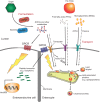The interplay between intestinal bacteria and host metabolism in health and disease: lessons from Drosophila melanogaster
- PMID: 26935105
- PMCID: PMC4833331
- DOI: 10.1242/dmm.023408
The interplay between intestinal bacteria and host metabolism in health and disease: lessons from Drosophila melanogaster
Abstract
All higher organisms negotiate a truce with their commensal microbes and battle pathogenic microbes on a daily basis. Much attention has been given to the role of the innate immune system in controlling intestinal microbes and to the strategies used by intestinal microbes to overcome the host immune response. However, it is becoming increasingly clear that the metabolisms of intestinal microbes and their hosts are linked and that this interaction is equally important for host health and well-being. For instance, an individual's array of commensal microbes can influence their predisposition to chronic metabolic diseases such as diabetes and obesity. A better understanding of host-microbe metabolic interactions is important in defining the molecular bases of these disorders and could potentially lead to new therapeutic avenues. Key advances in this area have been made using Drosophila melanogaster. Here, we review studies that have explored the impact of both commensal and pathogenic intestinal microbes on Drosophila carbohydrate and lipid metabolism. These studies have helped to elucidate the metabolites produced by intestinal microbes, the intestinal receptors that sense these metabolites, and the signaling pathways through which these metabolites manipulate host metabolism. Furthermore, they suggest that targeting microbial metabolism could represent an effective therapeutic strategy for human metabolic diseases and intestinal infection.
Keywords: Commensal; Drosophila melanogaster; Metabolism; Microbiota; Pathogen.
© 2016. Published by The Company of Biologists Ltd.
Conflict of interest statement
The authors declare no competing or financial interests.
Figures



Similar articles
-
Microbial Control of Intestinal Homeostasis via Enteroendocrine Cell Innate Immune Signaling.Trends Microbiol. 2020 Feb;28(2):141-149. doi: 10.1016/j.tim.2019.09.005. Epub 2019 Nov 4. Trends Microbiol. 2020. PMID: 31699645 Free PMC article. Review.
-
The role of the microbial environment in Drosophila post-embryonic development.Dev Comp Immunol. 2016 Nov;64:39-52. doi: 10.1016/j.dci.2016.01.017. Epub 2016 Jan 28. Dev Comp Immunol. 2016. PMID: 26827889 Review.
-
From pathogens to microbiota: How Drosophila intestinal stem cells react to gut microbes.Dev Comp Immunol. 2016 Nov;64:22-38. doi: 10.1016/j.dci.2016.02.008. Epub 2016 Feb 6. Dev Comp Immunol. 2016. PMID: 26855015 Review.
-
Drosophila as a model for intestinal dysbiosis and chronic inflammatory diseases.Dev Comp Immunol. 2014 Jan;42(1):102-10. doi: 10.1016/j.dci.2013.05.005. Epub 2013 May 16. Dev Comp Immunol. 2014. PMID: 23685204 Review.
-
How commensal microbes shape the physiology of Drosophila melanogaster.Curr Opin Insect Sci. 2020 Oct;41:92-99. doi: 10.1016/j.cois.2020.08.002. Epub 2020 Aug 14. Curr Opin Insect Sci. 2020. PMID: 32836177 Review.
Cited by
-
Bacillus thuringiensis Bioinsecticides Induce Developmental Defects in Non-Target Drosophila melanogaster Larvae.Insects. 2020 Oct 13;11(10):697. doi: 10.3390/insects11100697. Insects. 2020. PMID: 33066180 Free PMC article.
-
Symbiotic bracovirus of a parasite manipulates host lipid metabolism via tachykinin signaling.PLoS Pathog. 2021 Mar 1;17(3):e1009365. doi: 10.1371/journal.ppat.1009365. eCollection 2021 Mar. PLoS Pathog. 2021. PMID: 33647060 Free PMC article.
-
Intestinal regeneration as an insect resistance mechanism to entomopathogenic bacteria.Curr Opin Insect Sci. 2016 Jun;15:104-10. doi: 10.1016/j.cois.2016.04.008. Epub 2016 Apr 20. Curr Opin Insect Sci. 2016. PMID: 27436739 Free PMC article. Review.
-
High-sugar diet leads to loss of beneficial probiotics in housefly larvae guts.ISME J. 2024 Jan 8;18(1):wrae193. doi: 10.1093/ismejo/wrae193. ISME J. 2024. PMID: 39361901 Free PMC article.
-
Gut microbiota profiles of commercial laying hens infected with tumorigenic viruses.BMC Vet Res. 2020 Jun 29;16(1):218. doi: 10.1186/s12917-020-02430-3. BMC Vet Res. 2020. PMID: 32600312 Free PMC article.
References
-
- Ahmed T., Auble D., Berkley J. A., Black R., Ahern P. P., Hossain M., Hsieh A., Ireen S., Arabi M. and Gordon J. I. (2014). An evolving perspective about the origins of childhood undernutrition and nutritional interventions that includes the gut microbiome. Ann. N. Y. Acad. Sci. 1332, 22-38. 10.1111/nyas.12487 - DOI - PMC - PubMed
Publication types
MeSH terms
Grants and funding
LinkOut - more resources
Full Text Sources
Other Literature Sources
Molecular Biology Databases

